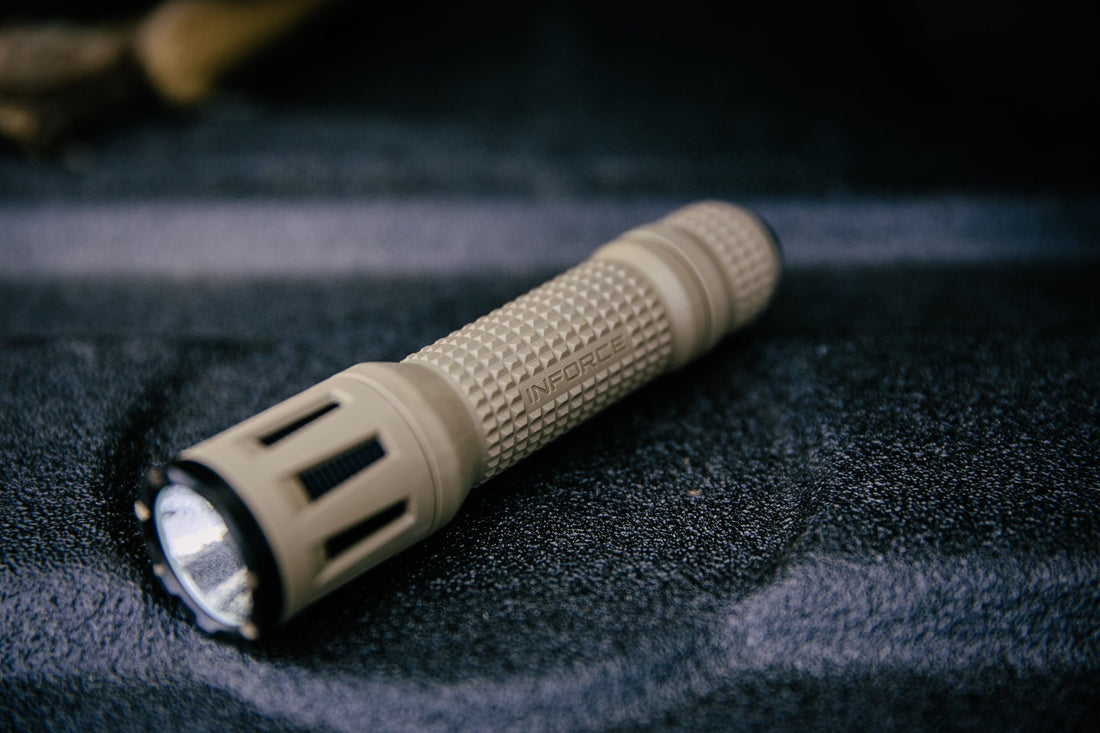Simply put, a flashlight is a handheld portable lighting device. It puts photons where you point and may even be mounted on a weapon.
A tactical flashlight, on the other hand, has a greater lumen and candela output than an ordinary flashlight. They are usually smaller and much more powerful than what you may think of as a traditional flashlight and are meant to take a fair amount of abuse.
Materials and features
One of the requirements of a good flashlight is its ability to withstand harsh conditions. Most handhelds in use today are constructed of aluminum or Nylon 6, a knurling of some sort on the body, and have a rear click switch that offers constant on and momentary modes. A parabolic reflector allows for a beam pattern that produces a bright hotspot for distance and noticeable side spill to illuminate a large peripheral area. Quality flashlights will use a white LED and measure their light emissions through Kelvin (K). A rating of 5000K is equivalent to direct sunlight and is optimum when bright illumination is needed. A more detailed explanation of the Kelvin color temperature can be found here.
Lumens and Candela
Lumens are a measurement that tells you the total amount of light emitting from the LED. It is important to note that the lumen number does not correlate to what you may see at a distance from the focused beam once the LED is placed into a reflector or any other type of optic. Candela can be described as the amount of light that is emitted in a certain direction. Typical modern flashlights use a parabolic reflector but there are many other types of optics that may be used such as Fresnel lens, convex lens, or Total Internal Reflection (TIR) lens. Modern high-performance flashlights usually have a lumen measurement from 500 to 1000 lumens and a candela from 25,000 all the way up to 60,000 or higher while utility flashlights have brightness levels anywhere from 25 to 100 lumens and very low candela.
Batteries and battery life
Lights producing a high number of lumens require CR 123a or rechargeable Lithium-Ion batteries, which are more efficient at delivering energy than a typical AA or other alkaline battery. However, because of the power consumption a high-powered flashlight uses they may only last up to 2 hours on its highest settings. In contrast, a regular flashlight which typically only has an on-off switch, can usually last ten hours or longer on regular alkaline batteries.
Ratings
Professional grade flashlights typically have IP (Ingress Protection) ratings, which indicate how well-protected a device is from water and in some cases, it defines how impervious it is to solid objects such as dust. Ingress Protection ratings begin with the letters IP followed by one or two numbers. The first number tells you the level of ingress of a solid object and the second letter dictates how impervious it is to water. Some flashlights may even have an IP68, which is highest IP rating for both dust and water resistance. A more detailed explanation of IP ratings can be found here
Users
Besides Law Enforcement, Military, and armed citizens, tactical flashlights are usually seen in the hands of search and rescue workers, survivalists, mechanics, outdoorsmen and others who value their high intensity beams and ruggedness. The once rare tactical light is so commonplace and affordable today that it has by and large taken the place of the regular flashlight for home use. This is especially true because most will not bother buying low-lumen flashlights simply because everyone has phones that do just as good of a job as a regular non-tactical flashlight from just a few years ago. Many tactical lights on the market today are equipped with the strobe function, which is meant for either signaling or self-defense, something the designers of typical flashlights are not concerned about.

